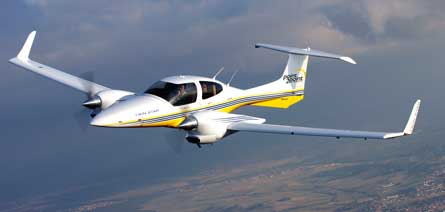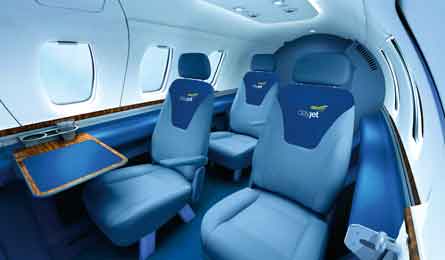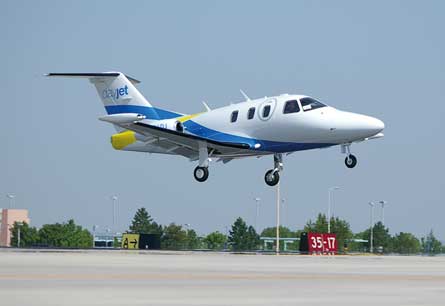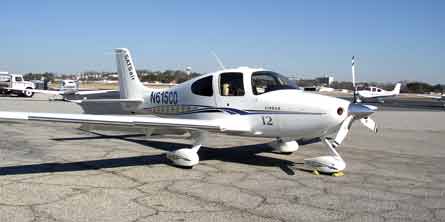After much hype, the air-taxi era in the USA is finally dawning. Can these on-demand services truly transform the dynamics of regional business travel?
Air taxis have changed Jimmy Durham’s life. The Greenville, South Carolina-based ice-rink developer has been using SATSair’s Cirrus SR22 piston singles for just over a year, and says he has saved hundreds of hours he would otherwise have spent travelling by car or scheduled airline to meetings all over the south-east USA. The former professional ice skater is typical of the sort of person the air-taxi sector wants to make its own – architects, attorneys, accountants and other entrepreneurs and executives who are not quite rich enough, or simply too financially canny, to opt for conventional business aviation using aircraft ownership, conventional charter or fractional schemes. Until now, they have been beyond the reach of business aviation.
|
|---|
Point2Point calls itself a "personal airline" rather than an air taxi service |
Emerging industry
Across the USA, a clutch of ambitious would-be air-taxi operators has emerged to exploit what they see as a latent market for fast and efficient no-frills business aviation, particularly – but not exclusively – in parts of the country poorly served by the airlines or where congestion or distance makes travelling by car a misery. For most – but not all – very light jets (VLJ) such as the Eclipse 500 and Diamond D-Jet have been the catalyst, affording for the first time the ability to transport up to four passengers speedily between small airfields two or three hours apart. At next week’s National Business Aviation Association convention in Orlando, Florida, the potential of the air-taxi sector will be one of the biggest themes, as the most talked about air-taxi operator and air-taxi aircraft – Florida’s DayJet and the newly certificated Eclipse 500 – get ready to begin service. Most of the other manufacturers and start-ups will be there to update the industry on their progress.
To their proponents, air taxis have the potential to both revitalise the USA’s stagnant general aviation industry and revolutionise the way America does business on the move. VLJs and latest-generation piston singles such as the SR22 represent a step-change in operating economics and image over traditional GA aircraft, say these evangelists. To businessmen like Durham, value-for-money personal air transport is “the way of the future”, allowing him, for the first time, to spend a day making a series of sales calls in cities hundreds of miles apart, and still be home, as he says, “for dinner in my favourite restaurant in Main Street”.
Risky business
The “air-taxi” epithet is convenient, but confusing. Each of the major services so far operating or planning to launch has a distinctive business model. Not all even call themselves air taxis. Only DayJet – which has 239 Eclipses on order – intends to immediately offer services on a per-seat basis. Although all of them plan to eventually operate VLJs, SATSair has built a successful regional business around the Carolinas and Virginia using SR22s. Linear Air, based near Boston, Massachusetts, has launched its service with Cessna Caravans, although it has 15 Eclipses on order. Some shun the air taxi moniker: Magnum, in Stamford, Connecticut – which has ordered 110 Adam A700s and 50 Embraer Phenom 100s – markets itself as an “air limousine” service; Point2Point of Bismark, North Dakota, another SR22 operator, insists it is a “personal airline”.
What brings the breed of air-taxi visionaries together is that they are all, to some extent, outsiders who believe they can inject new ideas into what has become a staid and inward-looking general aviation sector in North America. Although some have an aerospace background or are pilots in their own right, most claim to be importing ideas from other areas of the business world. DayJet founder Ed Iacobucci made his name in the information technology industry. William Herp of Linear Air has a Harvard MBA. Cameron Burr of Pogo has had a career in financial services. A lot of the capital behind the air-taxi start-ups has come from non-aviation sources too. Julian Robertson, the main investor behind Pogo, founded Tiger Management, one of the pioneers of hedge funds.
Of all the new air-taxi business models, DayJet’s is the most radical – and risky. If the company’s vision of a community of users sharing aircraft journeys between second-tier cities takes shape, it is likely to be highly profitable, with two or three fare-paying passengers making the most of aircraft utilisation. If the business community in launch state Florida proves sceptical, DayJet’s cost base could be its undoing: its Eclipse 500s will each have two pilots; it has been paying 70 staff for months before the start of revenue service; and it has spent heavily on marketing and a complex computer system that allocates its aircraft by predicting demand.
Iacobucci – a former associate of Eclipse Aviation founder Vern Raburn – has no doubt he has his sums right. Announced in 2002, DayJet plans to set up bases at a network of underused local airports, called DayPorts, from where it will try to match travellers who want to go from one to the other at roughly the same time.
Creating connections
The break-even number of passengers on each flight is 1.3, says Iacobucci, so every time one of its Eclipse 500s carries two or more, the trip is profitable. Because it operates under Part 135 rules, DayJet cannot publish schedules, but users will be encouraged to widen the window during which they intend to travel to accommodate fellow passengers and lower the price per seat. Each aircraft may stop to pick up another passenger en route, but not more than once, says Iacobucci.
|
|---|
DayJet will take delivery of its first batch of Eclipse 50 VLJs within weeks |
It sounds like a complicated model, but Iacobucci says the strategy is all about “developing markets with enough demand to justify point-to-point travel”. He adds: “There are a lot of professionals today who get in a car and drive. They can afford more, but they don’t have any option.” DayJet’s initial bases – at Boca Raton, Gainesville, Lakeland, Pensacola and Tallahassee – are all cities with thriving business communities, but poor airline connections, he says. Although prices will vary, Iacobucci says a typical fare from Boca Raton to Tallahassee, the state capital, on DayJet might be around $1,000. “A normal charter would be $2,000-3,000, and that’s before you pay for the deadhead [returning the empty aircraft to its base]. We take the deadhead out of the picture.”
Iacobucci says DayJet will receive its first aircraft within weeks and will have around 12 in its fleet when it launches revenue flights at the end of the year. By early 2007, the operator will have between eight and 10 DayPorts.
Customer confidence
This will rise to around 15 by the end of next year, by which time its fleet of Eclipses will be in three figures. The company is busy recruiting its first pilots and Iacobucci says he has received 1,400 applications. “We’re looking for a very specific type,” he says. “They have to be service- and customer-oriented. We’ve spent a lot of time on the process to make sure we’re matching the culture of the company.”
|
|---|
Each of DayJet's Eclipse 500s will have two pilots, a costly and possibly risky strategy |
Entry levels will be high, including at least 3,000h on multi-engine aircraft, so Iacobucci expects most recruits to be about-to-retire airline captains or experienced pilots from the charter or fractional sectors. “It will be an open cockpit, so it’s very different to what a 777 pilot will be dealing with today,” he says. Some have described DayJet’s insistence on having two pilots as “overkill”, given the Eclipse 500’s level of cockpit automation. “The workload itself will be low in terms of operations, but we think it is right in terms of customer confidence and creating a pleasant experience,” he says. DayJet believes its system of so-called DayBases, where pilots will be domiciled, is key to recruiting the right people. Pilots will work shifts with “zero overnighters”, says Iacobucci. “We will treat our pilots like we do our customers, who want to take a day trip and be home at night, rather than having the sort of haphazard schedules that most pilots are used to nowadays.”
DayJet raised $28 million in its first round of financing. The next phase, says Iacobucci, requires another $25 million, and “we’re working on that”. Next year will see one final round of raising private capital and, “after that, the board will have to take a decision to stay private or go public”.
With the southern reach of its territory just overlapping DayJet’s in northern Florida, SATSair (the SATS stands for smart air travel solutions, but echoes NASA’s small aircraft transportation system programme), has been running air-taxi services since July 2005, and is one of only two or three operators in the USA with a functioning network.
Business philosophy
Its base is the South Carolina city of Greenville, home to BMW’s North American factory and several other international companies and typical of many US cities, in that its airport is a spoke on two airline networks and there are few direct flights other than to their hubs. Founded by ex-Raytheon Aircraft boss Steve Hanvey, SATSair started life as a conventional charter business and adopted the air-taxi model after acquiring its first SR22, of which it now has 16. The business is funded by private investors, but manufacturer Cirrus Design bought a 21% stake in February this year. SATSair sees itself as “filling a gap between fractionals and mom and pop charter businesses”, says vice-president business systems Phil Quist.
Aside from using SR22s, SATSair’s business philosophy is different to that of its neighbour to the south. For a start, it focuses on offering complete aircraft rather than individual seats. It also flies “pretty much anywhere within the range of the aircraft”, says Quist. “This year so far, we’ve served 350 airports in the south-east. The aircraft can land anywhere where there is a 3,000ft [915m] runway.” When SATSair started, the vast majority of its passengers originated in Greenville. Today, with aircraft and pilots based at eight cities – from Manassas, Virginia near Washington DC to Pensacola, Florida – around three in every five flights begin away from Greenville.
Another difference from DayJet is that “we are not preoccupied with getting the pilot back every night”, says Quist, with the focus much more on routeing aircraft to where they are needed next. But as SATSair “builds its density, we will get to a critical mass where it might be possible to get the pilot home at night rather than having four nights on the road”. Because, unlike with conventional charter, customers only pay for the occupied leg of their journey, the key to utilising the aircraft is “strategically placing it in our network. We need to be efficient in doing this or we are out of business,” says Quist.
Leisure links
Although the SR22s can carry up to three passengers, with one sitting next to the pilot, the average passenger number is 1.7 and it tends to be at the leisure end of the business, where a customer will typically fly with family or golfing colleagues, when the aircraft is full, says Quist. It costs $595 an hour to hire an aircraft (regardless of the number of passengers), coming down to $420 an hour for a pre-purchased 50h package. SATSair is flying around 1,000 passengers a month and Quist says “the opportunity is bigger than we expected”. Although it plans to add around one SR22 every month, the company is also looking at acquiring a small number of VLJs to increase the radius it can serve. “Today, we have people flying from Washington DC down to Miami, but they have to make fuel stops. Once the VLJs come in, we can extend up to New York and down to Florida,” says Quist. On the evaluation list are the D-Jet and Eclipse, although it is likely that SATSair would be a candidate for any VLJ that Cirrus develops.
|
|---|
SATSair has 16 SR22s, seating up to three passengers, and plans to add one extra jet every month |
Point2Point, founded in Bismark, North Dakota by former commercial pilot John Boehle, differs from the other air-taxi operators in that it is based in a region of the USA with almost no airline connections. “From Bismark, a vibrant and growing community of 100,000-plus people, you can fly to three places in the whole world,” he remarks. Boehle claims Point2Point is a “breakthrough” for local business people who “now have access to the sort of personal aviation that sports stars, celebrities and top-paid executives have enjoyed since the inception of modern aviation”. The company, which launched in the final quarter of last year, has a fleet of three SR22s and two Diamond DA42 Twin Stars, but plans to acquire up to 30 more Twin Stars by the end of 2007 and, once the single-engined jet enters service in mid-2008, up to 50 D-Jets. The company signed its order for “up to 100 aircraft” with the Austrian manufacturer at the Oshkosh AirVenture show in July. Although Point2Point also has two Eclipse 500s on order, the D-Jet got the nod over its competitors for the major order because of its “cavernous cabin for three passengers”, says Boehle. “There is all the headroom in the world.”
Door-to-door service
Each of Point2Point’s aircraft is flying four or five round trips a week, averaging 3-4h a time. Boehle says his Mid-Western customers tend to be unostentatious and conservative, preferring the no-nonsense value of air taxis to more upmarket business jets. “One of my biggest customers is a regional accountancy firm, so you can imagine they have very sharp pencils,” he says. Although the Plains region Point2Point serves is thinly populated, there is no shortage of airports, including 63 its aircraft can use in North Dakota. “What we can offer is a true door-to-door service,” says Boehle. “And the communities welcome us with open arms, because we bring in business for these small airports, taxi firms and other local businesses.” He notes the example of Mount Vernon, Illinois: “They have an airport but no scheduled service, so they were ecstatic at the prospect of us moving in.”
Linear Air, meanwhile, plans to serve a different market – the most densely populated region of the USA, around New York City and Boston. The company launched its operation two years ago as a per-seat charter business using Cessna Caravans, including shuttling city executives to their coastal vacation homes in Nantucket and Martha’s Vineyard. This was intended to introduce the Linear Air brand and the concept of private flying to its target business market before the service launches properly next year with Eclipse 500s, says chief executive William Herp, a Harvard MBA who founded the company with experienced aviator Michael Goulian. Around 600 people have used the service, 400 of them more than once.
Once the Eclipses come on stream, the company will change its model to whole aircraft charter, targeting “small teams on day trips of 300-500 miles [480-800km]”. Beginning from Hanscombe Field, a small airport near Boston, the company plans to open bases near New York, Washington DC and then on the West Coast, each airport serving a radius of around 800km.
Herp has no qualms about launching in a region where airline services and business aviation providers abound. The charter sector is typified by hundreds of “mom and pop businesses”, he says. “The problem is who do you call? Yes, you can use a broker, but the reason they exist is to take a margin. They only exist because of the fragmented industry.” As for airline competition, Herp admits Linear Air will not be competitive on the Boston to New York City shuttle route. “But say you want to go from Boston to Elmira, New York. You will have to go through Newark and leave at 5am and get home at 11pm and it’s still $700. We will charge $3,000 for the aircraft with a much higher level of service, including leaving from secondary airfields.”
Herp says Linear Air will be operating 300 aircraft by the end of next decade and believes the “radically different economics of very light jets” make air taxis viable. Because aircraft will invariably return to their base each night and fly only 1,000h a year, there are “no operating challenges”, compared with the model being proposed by DayJet, says Herp. “As we scale up there will be these sorts of challenges, but our model is simpler.” As with most of the air-taxi operators, Linear Air is in the midst of raising capital – it has generated $3.5 million so far and is seeking a further $6 million by the end of the year.
Magnum Jet is the only air-taxi operator to commit to the Phenom 100 and Adam A700. It also has options for the Embraer VLJ’s bigger sister, the Phenom 300. Based in Houston, Texas, Magnum plans to launch operations from Stamford, Connecticut once deliveries of its A700s begin around April next year, rolling out to Texas, Los Angeles, San Francisco, Denver, Phoenix, Salt Lake City and Las Vegas, says chief executive Jim Burns. Like most of the other air-taxi operators, Magnum intends to offer entire aircraft rather than individual seats, although “we may do per seat at some point”. Critically, he says, “air taxis will be the biggest change in aviation for 20 years”, with VLJs offering fuel savings of between 25% and 75% over larger aircraft.
With backing from the National Bank of Canada ensuring that “we have plenty of capital”, Burns is relaxed about being behind some of his competitors who have opted for the Eclipse. “It’s a marathon, not a sprint,” he says. “We’ve been doing this for two years and have had delivery slots for ages.” He is convinced about his choice of aircraft: significantly the A700’s inclusion of a lavatory. “People joke about this, but it’s pretty critical,” he says. “To me, choosing an aircraft without a lav is a gigantic mistake.” The A700’s cabin size was also a factor. “It can comfortably handle four, if not five passengers,” he says. “The Eclipse is tiny and quite uncomfortable.”
Pogo announced a deal for 75 A700s in May 2004, when it planned to begin operation in 2005, but now the company will not confirm what aircraft it intends to buy – although the Eclipse 500 is “front runner” – and it does not plan to launch operations until mid-2008, when it will begin offering flights from its base at Westover, Massachusetts. “I’m ecstatic at being where we are,” says president and founder Cameron Burr. “When you start something like this, you have to ramp up a business with a lot of expenses and you burn a lot of money getting your Part 135,” he says. Although the company has secured $15 million in capital, including from main investor Julian Robertson, and has former American Airlines boss Robert Crandall as its chief executive, it has only five people on its payroll.
The delay, says Burr, is partly to learn from others’ mistakes and because the US Federal Aviation Administration has yet to rule on a number of key issues around the operation of air taxis, including how it will treat the on-demand sale of single seats by companies operating Part 23 aircraft under a Part 135 certificate. “If one person is seen to be setting a schedule, then are you talking about a Part 25 aircraft?” he asks.
Paradigm shift
There are those who predict that the whole air-taxi phenomenon may crash dot-com-style, in a messy explosion of over-capitalisation, over-regulation and sluggish customer take-up. However, the FAA certification of the Eclipse 500 – the model of choice for two of the air-taxi giants that have so far declared their hand – has given a boost to the sector. The arrival on the market of the A700, Phenom 100 and D-Jet in the next two years should also add momentum. But with no VLJs as yet in operation and with only the early experience of the SR22 operators to go by, time will tell if air taxis will provide the promised paradigm shift in business aviation, converting thousands not just from commercial air transport, but from the car.
According to Adam Aircraft chief executive Joe Walker, it will not be until 2009 or 2010 before “we begin to know what the true market for air taxis is”. Until then, manufacturers will not be able to ramp up production fast enough to meet demand. “There are four or five different business models out there,” he says. “Eventually we will find out which one works. But, until then, one thing is for sure: they will all need an airplane.”
Read Murdo Morrison’s air taxis blog by visiting the blogs section on flightglobal.com
Source: Flight International
























